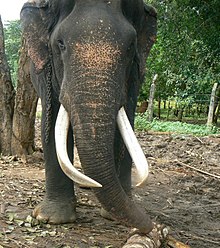
Back فيل سريلانكي Arabic فيل سريلانكى ARZ Fuzol (Elephas maximus maximus) AVK Seylon fili Azerbaijani Цейлонски слон Bulgarian Slon cejlonský Czech Sri-Lanka-Elefant German Ελέφαντας της Σρι Λάνκα Greek Elephas maximus maximus Spanish فیل سریلانکایی Persian
| Sri Lankan elephant | |
|---|---|

| |
| Male tusker | |

| |
| Female and juveniles in Yala National Park | |
| Scientific classification | |
| Domain: | Eukaryota |
| Kingdom: | Animalia |
| Phylum: | Chordata |
| Class: | Mammalia |
| Order: | Proboscidea |
| Family: | Elephantidae |
| Genus: | Elephas |
| Species: | |
| Subspecies: | E. m. maximus
|
| Trinomial name | |
| Elephas maximus maximus | |

| |
| Range of the Sri Lankan elephant | |

The Sri Lankan elephant (Elephas maximus maximus) is native to Sri Lanka and one of three recognised subspecies of the Asian elephant. It is the type subspecies of the Asian elephant and was first described by Carl Linnaeus under the binomial Elephas maximus in 1758.[1] The Sri Lankan elephant population is now largely restricted to the dry zone in the north, east and southeast of Sri Lanka. Elephants are present in Udawalawe National Park, Yala National Park, Lunugamvehera National Park, Wilpattu National Park and Minneriya National Park but also live outside protected areas. It is estimated that Sri Lanka has the highest density of elephants in Asia. Human-elephant conflict is increasing due to conversion of elephant habitat to settlements and permanent cultivation.[2]
- ^ Linnaeus, Carl (1760). "Elephas maximus". Systema naturæ per regna tria naturæ, secundum classes, ordines, genera, species, cum characteribus, differentiis, synonymis, locis [System of nature through the three kingdoms of nature, according to classes, orders, genera and species, with characters, differences, synonyms, places] (in Latin). Vol. 1. Halle an der Saale: Typis et sumtibus Io. Iac. Curt. p. 33.
- ^ Fernando, Prithiviraj; Jayewardene, Jayantha; Prasad, Tharaka; Hendavitharana, W.; Pastorini, Jennifer (2011). "Current Status of Asian Elephants in Sri Lanka" (PDF). Gajah. 35: 93–103. Archived (PDF) from the original on 1 September 2022. Retrieved 3 September 2013.